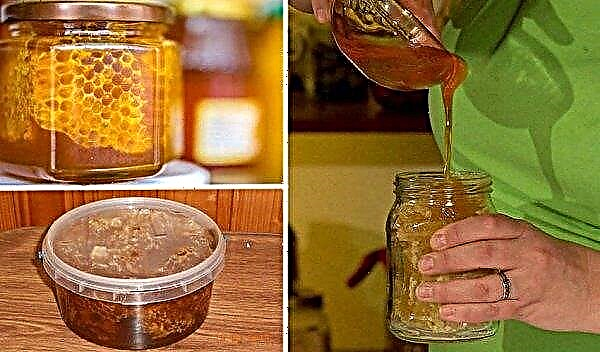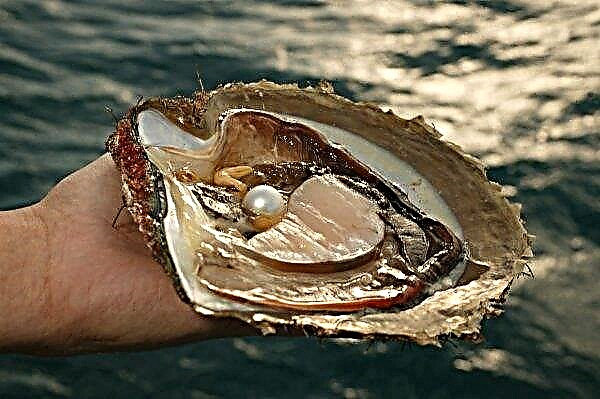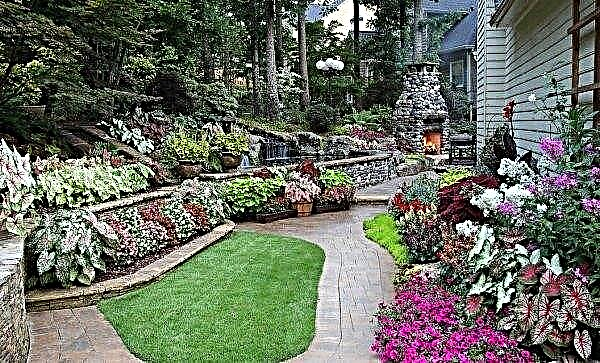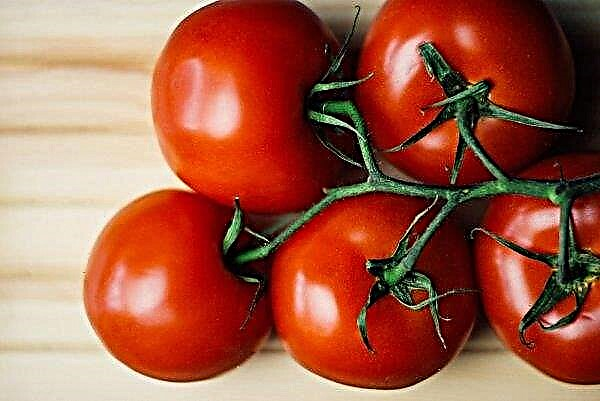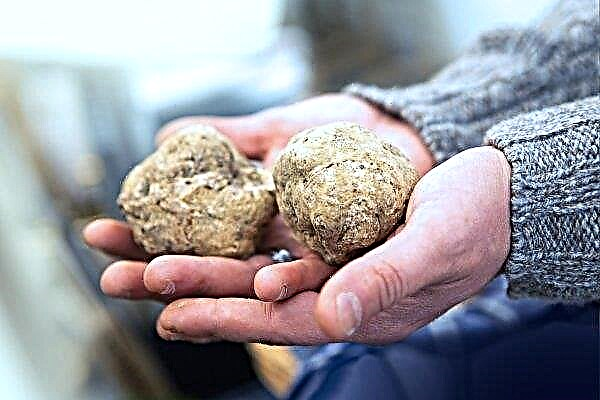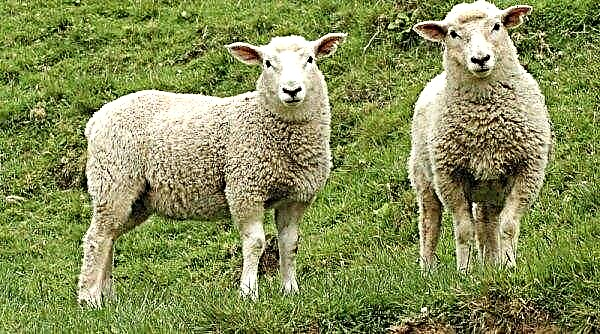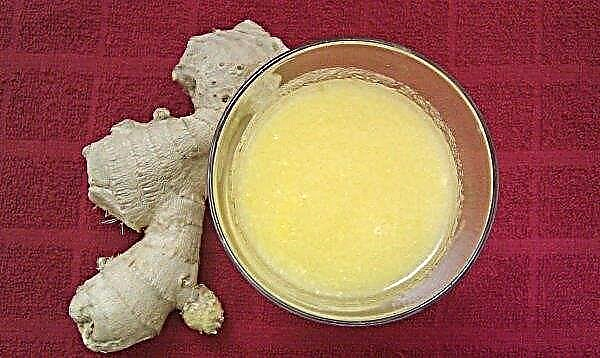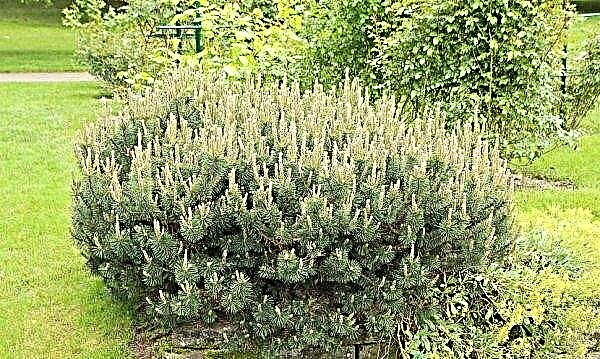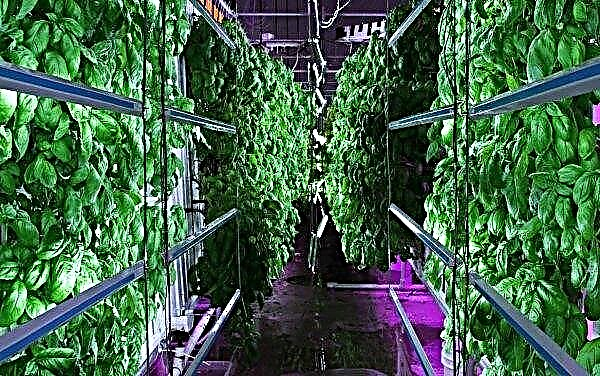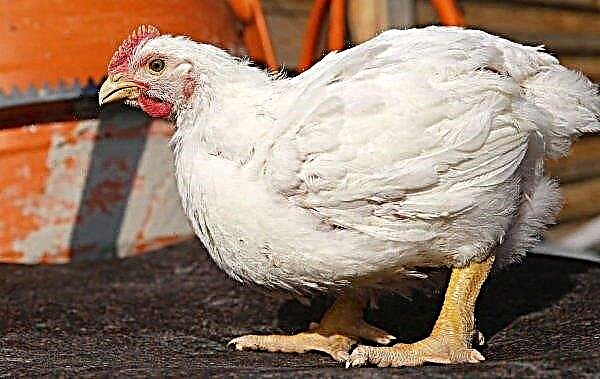Among the most popular vegetables for growing on a personal plot, the leading position is held by tomatoes, of which there are dozens or even hundreds of varieties today. Quite popular among this variety are Khokhloma tomatoes, bred by Russian breeders. What is the peculiarity of these tomatoes, how to grow them correctly, and how to care for them - let's figure it out.
Grade description
Khokhloma tomatoes are the result of selection by employees of the Russian agronomic company Gavrish. In the Russian state register, this variety was included in 2004 as a tomato, intended for planting and cultivation on closed and open ground. The plant is a type of indeterminate (that is, having no points of growth termination), non-hybrid, mid-ripe carpal cultures, which have the following characteristics:
- Bush: grows up to 2 m high, needs support and in the further formation of leaves due to pinching.
- Leaves: medium in size, slightly wrinkled with a small edge, distinguished by a dark green color.
- Inflorescence: simple, formed on 8–9 leaf, and then formed through 3 sheets. The brush can form up to 11 berries, while they hold firmly and do not fall.
- Fruit: slightly elongated, cylinder shape, medium in size. In the ripeness phase, they acquire a red color, can reach a weight of 100–130 g. They have a pleasant sweet and sour taste, a fairly dense peel that does not deteriorate during transportation. The fruits of Khokhloma are universal, widely used for canning and fresh consumption.
- Productivity: subject to all the nuances of agricultural technology can be assembled with 1 square. m 8-10 kg of fruit.
- Immunity: the variety is resistant to certain ailments, in particular late blight, tobacco mosaic, fusarium, and top rot.

Advantages and disadvantages
- Growing tomatoes of this variety gives gardeners a number of advantages:
- subject to the rules of planting and care, you can get a high yield;
- the fruits have a wonderful taste, dense structure, can be stored for a long time and easily transported without losing their original appearance;
- tomatoes are easy to grow;
- plants have good resistance to many ailments that traditionally affect tomatoes;
- fruits are universal in application;
- bear fruit throughout the season, which makes it possible to eat fresh vegetables constantly;
- can be grown both in open soil and in greenhouses.
- Among the few shortcomings of Khokhloma are the following:
- lack of juiciness of fruits and their certain dryness;
- inability to get a lot of juice.
Did you know? Tomatoes are the closest relatives of potatoes and tobacco. All of them belong to the Solanaceae family.
Sowing seeds for seedlings
Tomatoes of this variety are suitable for growing in greenhouses and on open ground, but the amount of yield in the latter case will be slightly lower. Before planting tomatoes on the garden, you should prepare seedlings.
Optimal timing
If the seedlings are planted in a greenhouse, then the end of March and April are considered the optimal period. Landing in open soil is recommended to be postponed to May, but at the same time check the heating of the soil. Its temperature indicators should be at least 14 ° C.

Soil mix
The soil mixture for growing seedlings should be as light, loose, enriched with nutrients. In most cases, apply soil with the following composition: chernozem and humus in a ratio of 1: 2. You can also use a mixture of equal parts of chernozem, special soil for seedlings and fine sand. There is no single recipe for the soil composition for tomatoes; each one is selected individually.
If garden soil is used for seedlings, then it must be disinfected from possible parasites and pests.For disinfection, you can use one of the popular methods:
- Annealing the soil in the oven for 15–20 minutes at a temperature of 180–200 ° C.
- Warming up the earth in a microwave for 1-2 minutes at a power of 850-900 watts.
- Disinfection of soil with potassium permanganate solution. The soil is poured with a concentrated solution of potassium permanganate and allowed to dry.

Capacity for growing
For sowing seeds for seedlings, any containers can be used: disposable plastic cups, special boxes - cassettes, ordinary rectangular boxes or peat tablets. The latter are the simplest and best option, since it involves the further planting of seedlings along with conditional packaging.
Seed preparation
Before sowing, tomato seeds must be prepared in a special way.
Important! Pre-packaged store seed seedlings have already passed the necessary disinfection and do not need additional processing.
If the seeds were purchased by weight or collected with their own hands, then they should be disinfected using one of the following solutions:
- Dissolve 1 g of potassium permanganate in 100 ml of pure water, put the seeds in a napkin and keep in the mixture for no more than 15–20 minutes;
- Mix 0.5 g of soda with 100 ml of water, withstand the seeds in this mixture for about a day;
- Dilute 1 drop of Fitosporin in 100 ml of water, dip the seed into the solution for 1-2 hours.

Disinfection of seeds will help to neutralize them from possible pests and parasites, as well as strengthen the immunity of seedlings, increase the yield of the plant and its fertility.
Sowing seeds
Previously prepared and disinfected soil, it is necessary to fill up the containers for seedlings and make recesses in the soil up to 1 cm. In this case, the distance between the barbs should be 3-4 cm, and the interval between the seeds should be 1-2 cm. Seeds should be lowered into the hole, slightly pressed and gently sprinkle with soil. After sowing, the ground must be sprayed with water using a spray gun.
When the soil settles, the container with seeds must be covered with plastic wrap and put in a warm, dry place, in which the temperature varies between 25-30 ° C. It is allowed to place boxes near the battery or heating devices.
Seedling Care
Checking the state of seedlings is recommended daily. To do this, inspect the soil: with strong drying, it is sprayed with water from the spray gun, and in case of excessive humidity, the film is removed and dried.
Important! In some cases, excess moisture in the soil can form mold on its surface. In such cases, the topsoil should be removed, replaced with a new one, and the whole soil should be shed with a potassium permanganate solution.
It is not recommended to lower the temperature in the room until the first shoots appear, and as soon as they appear, the film needs to be removed. Watering the sprouts is necessary as the soil dries. For irrigation, it is better to use clean, settled water at room temperature. Rain water is considered ideal.

Growing strong, high-quality seedlings is impossible without the organization of good lighting. It is necessary to place containers with shoots in the brightest place. In the absence of proper lighting, an additional light source should be installed, which will be a traditional fluorescent lamp. After 1 week after germination, the temperature in the room should be reduced to 17-19 ° C. It is also recommended to do daily ventilation of the room, but not to allow drafts.
2-3 weeks after the appearance of sprouts, the soil must be enriched with fertilizers, which are subsequently recommended to be applied weekly. For top dressing, it is best to use organic products made from manure or grass. Suitable store fertilizers based on biological humus, guano.
Seedling hardening
Approximately 1–1.5 months after seedling, seedlings expel flower brushes. This is a signal that after 10-15 days it must be planted. But before proceeding to planting, it is necessary to harden the sprouts, which will increase the immunity of the plant, help to adapt more easily to environmental conditions and recover.
Hardening is carried out as follows:
- 1-2 weeks before transplanting seedlings to a permanent place, it is necessary to lower the temperature in the room at night to 12-14 ° C.
- The temperature reduction must be carried out systematically in such a way that 5 days before disembarkation it equals the ambient temperature. To do this, it is recommended to take the container with sprouts to the glazed balcony and leave it around the clock. Sudden temperature changes must not be allowed.
- In parallel with the temperature hardening of the plant, it is necessary to harden its root system by creating more severe conditions - reducing the number of irrigations. Watering volumes should be left unchanged, and only time intervals between soil moisture should be changed. Such events will help to slightly stop the growth of seedlings and at the same time form a more solid, strong root system. At the same time, it is very important to prevent overdrying of the soil, as seedlings will begin to drop leaves.
- A few days before planting, it is necessary to fertilize the tomatoes using a solution of ammonium nitrate, potassium sulfate, Kristallon. Fertilizers will make it possible to increase the number of sprouted shoots by almost 100%.
- On the last day, the seedlings should be taken out to fresh air and left until they are directly discharged into the ground.

Did you know? In different countries of the world, tomatoes are called apples. For example, in Germany they were called "apples of paradise", and in France they are called "apples of love."
Planting seedlings in a permanent place
Seedlings are planted in previously prepared, loosened soil, enriched with organic fertilizers - humus, manure or ash. The most optimal tomato predecessors in the garden are onions, carrots or cabbage.
Sprouts are suitable for planting, aged 55-60 days. It is not recommended to plant plants too densely, the optimal scheme is 40 × 70, where per 1 square. m of soil has no more than 4 bushes. In order to achieve maximum plant productivity, experts recommend stepsoning every 7–10 days, removing shoots (stepsons) from the stem less than 4 cm long. A bush must be formed into 1 stem so that the fruits receive maximum nutrients.

You should also remove the lower leaves, which, firstly, impede the full development of tomatoes and “take away” valuable components necessary for ripening fruits, and secondly, spores of ailments, for example, phytophthora, are collected on moist soil.
Important! If you over seedlings in containers and let it bloom, then it will stop its vegetative development, remain in the phase of "undergrowth" and will not be able to give a quality crop.
How to care
After transplanting seedlings, it is necessary to organize traditional care for all tomatoes, which consists in timely watering, fertilizing, pinching and processing from pests.
Watering
Watering tomatoes is recommended rarely, but plentifully, pouring water directly into the hole. For irrigation, it is better to use well-defended water, at least 0.7-0.9 l of water will be required per 1 bush. The best time for watering is cloudy weather or evening, when there is no direct sunlight.

It is imperative to water tomatoes:
- during their flowering and fruit formation;
- before loosening the soil;
- after top dressing with dry fertilizers.
Top dressing
The first feeding of tomatoes is carried out 2 weeks after planting. As fertilizers, a mixture of mineral and organic components is used. For example, water is mixed with mullein in a ratio of 9: 1 and 20 g of superphosphate are added. The resulting solution is fertilized with approximately 10 bushes.
The second part of the fertilizer is recommended to be applied after loosening the soil or under hilling. In this case, special dry fertilizers are perfect. After 2 weeks, you need to carry out the third top dressing, using a dry mixture of 20 g of superphosphate, 15 g of potassium salt and 10 g of saltpeter.

Stepson
In the process of growing tomatoes, special attention should be paid to the formation of the bush. As practice shows, high yield indicators give plants that are formed into one stem, with 2-3 brushes. Therefore, you need to remove several pieces (not all at once) of the lower leaves every 1.5 weeks, and also remove small stepsons 3-4 cm in size every 10 days.
Important! The more often stepsoning will be carried out, the better lateral shoots will develop and the higher will be the yield of the bush.
Soil care
After each moistening of the soil, it is recommended to loosen it. It should be noted that the first cultivation is carried out quite deeply, up to 8-12 cm, which will make it possible to enrich the earth with oxygen and create the necessary conditions for its heating. Together with loosening, weeding is carried out. Subsequently, the soil is systematically loosened, with a depth of up to 5 cm, avoiding strong compaction of the soil, as this negatively affects the root system.

To reduce the amount of watering and accelerate the ripening of fruits, you need to mulch using peat, straw or sawdust, which are lined between the rows. Siderats are considered an excellent component of mulch for tomatoes, which favorably affect the productivity of vegetables.
In cases where subordinate roots have formed on the stalk of the plant near the soil, experts advise to carry out the hilling of tomatoes, which will enrich the soil with oxygen, stimulate root development, additionally nourish and strengthen the plant.
Bush tying
Tomato bushes need a garter, which is carried out by several methods:
- Stakes. Pegs made of wood are inserted into the soil on the north side of the bush, at a distance of 9-12 cm from the stem. At the same time, the garter is done in 3 doses: the first time immediately after planting the seedlings, the second and third - as the bush develops, at the level of the second and third hands.
- Tapestries. In this case, wooden stakes are inserted into the soil with an interval of 4 m, between which a special rope is pulled.

Preventative treatment
Tomatoes of the Khokhloma variety are highly resistant to ailments and parasites, however, do not forget about preventative measures, which include:
- systematic loosening and digging of the soil;
- timely weeding of soil from weeds;
- regular dusting of soil with ash;
- processing bushes three weeks before harvesting with a solution of copper sulfate, at the rate of 4 g of funds per 1 liter of water.

Khokhloma tomatoes will be an excellent solution for those who prefer dense, hard and tasty fruits that can be stored for a long time without losing their aesthetic and taste.In addition, the variety is unpretentious in care, resistant to diseases, has a high yield and requires the gardener to only follow the traditional rules of agricultural technology.
Network user reviews
ADVANTAGES: beautiful looking and tasty in salted form DISADVANTAGES: not yet Hello dear readers! This review will be devoted to tomato seeds under such an interesting name "Khokhloma". Perhaps the variety was named for the abundant amount of tomatoes on one bush. Last year we planted a similar variety in appearance; I don’t remember the name only. Very salty in the form of salt, the skin is thin. Of course, you can eat fresh, but the salad is not that, the tomatoes are plump and not as fleshy as large varieties. To decorate the festive table and beautiful cuts, it will suit perfectly, since it is not too soft. I can recommend those who like to make blanks for the winter.

